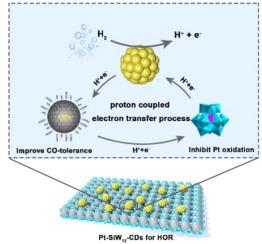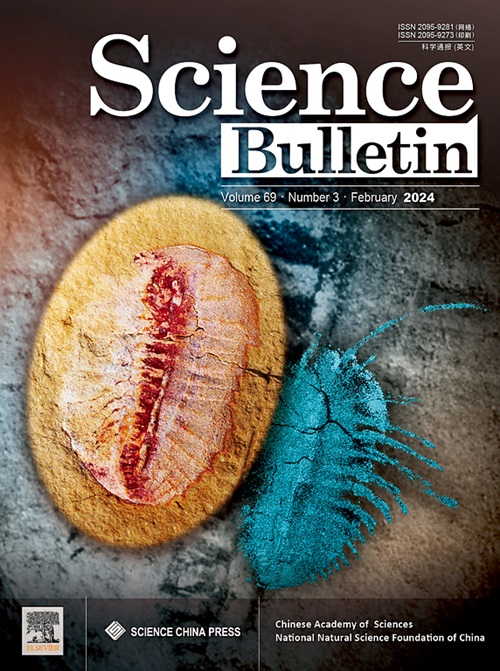Synergistic enhancement of Pt electrocatalyst stability and activity in hydrogen oxidation reaction by polyoxometalate and carbon dot co-boosting
IF 21.1
1区 综合性期刊
Q1 MULTIDISCIPLINARY SCIENCES
引用次数: 0
Abstract
Pt-based catalysts are prone to oxidation and CO poisoning during the hydrogen oxidation reaction (HOR), leading to deactivation, which has presented significant challenges for the application of proton exchange membrane fuel cells (PEMFC). Here, we propose a dual-protection strategy with the advantages of Pt-polyoxometalates (POMs) and carbon dots (CDs) to synthesize an advanced POMs-CDs based electrocatalyst, Pt-SiW12-CDs, with Pt clusters dispersed on SiW12-CDs substrates. It exhibited exceptional HOR performance, achieving a mass activity of 10.36 A mgPt−1 at an overpotential of 50 mV, which is over 54 times greater than that of Pt/C (0.19 A mgPt–1). These catalysts also display impressive stability and CO tolerance. By employing X-ray absorption fine structure (XAFS) spectra, transient photovoltage (TPV), transient potential scanning (TPS), and density functional theory (DFT) calculation, the in-depth investigation suggested the muti-roles of SiW12 and CDs for synergistic enhancement of Pt electrocatalyst stability and activity in HOR process. CDs act as bridges, effectively and rapidly transferring protons and electrons to SiW12 from Pt clusters. CDs can effectively coordinate with Pt, regulating its electronic structure while pre-occupying Pt sites, thus hindering CO adsorption on Pt. The reduced SiW12 efficiently transfers electrons to Pt, inhibiting the oxidation of Pt. Additionally, SiW12 also serves as the driving force, maintaining the rapid progression of the HOR process. The dual-protection strategy provides new ideas and directions for design of efficient and stable heterogeneous catalyst.

多金属氧酸盐与碳点协同增强氢氧化反应中Pt电催化剂的稳定性和活性。
pt基催化剂在氢氧化反应(HOR)过程中容易氧化和CO中毒,导致失活,这对质子交换膜燃料电池(PEMFC)的应用提出了重大挑战。本文提出了利用聚金属氧酸盐(POMs)和碳点(CDs)的双重保护策略,合成了一种基于POMs-CDs的先进电催化剂Pt-SiW12-CDs,并将Pt簇分散在SiW12-CDs衬底上。它表现出优异的HOR性能,在过电位为50 mV时达到10.36 a mgPt-1的质量活性,是Pt/C (0.19 a mgPt-1)的54倍以上。这些催化剂还表现出令人印象深刻的稳定性和CO耐受性。通过x射线吸收精细结构(XAFS)光谱、瞬态光电压(TPV)、瞬态电位扫描(TPS)和密度泛函理论(DFT)计算,深入研究了SiW12和CDs在HOR过程中协同增强Pt电催化剂稳定性和活性的多重作用。CDs作为桥梁,有效和快速地将质子和电子从Pt簇转移到SiW12。CDs可以有效地与Pt配合,在预先占据Pt位点的同时调节Pt的电子结构,从而阻碍CO在Pt上的吸附。还原后的SiW12有效地将电子转移到Pt上,抑制Pt的氧化。此外,SiW12还起到了驱动作用,维持了HOR过程的快速进行。双保护策略为设计高效稳定的多相催化剂提供了新的思路和方向。
本文章由计算机程序翻译,如有差异,请以英文原文为准。
求助全文
约1分钟内获得全文
求助全文
来源期刊

Science Bulletin
MULTIDISCIPLINARY SCIENCES-
CiteScore
24.60
自引率
2.10%
发文量
8092
期刊介绍:
Science Bulletin (Sci. Bull., formerly known as Chinese Science Bulletin) is a multidisciplinary academic journal supervised by the Chinese Academy of Sciences (CAS) and co-sponsored by the CAS and the National Natural Science Foundation of China (NSFC). Sci. Bull. is a semi-monthly international journal publishing high-caliber peer-reviewed research on a broad range of natural sciences and high-tech fields on the basis of its originality, scientific significance and whether it is of general interest. In addition, we are committed to serving the scientific community with immediate, authoritative news and valuable insights into upcoming trends around the globe.
 求助内容:
求助内容: 应助结果提醒方式:
应助结果提醒方式:


